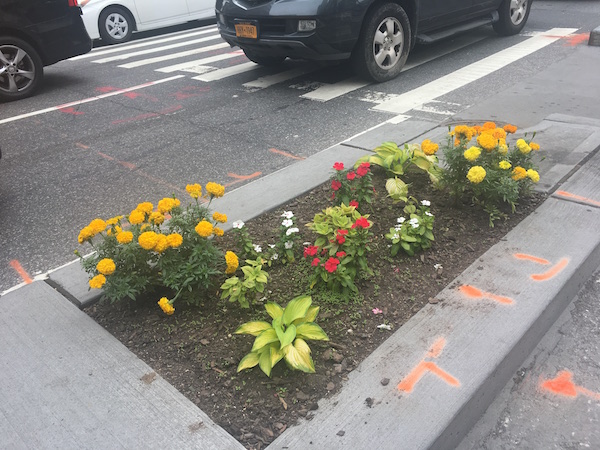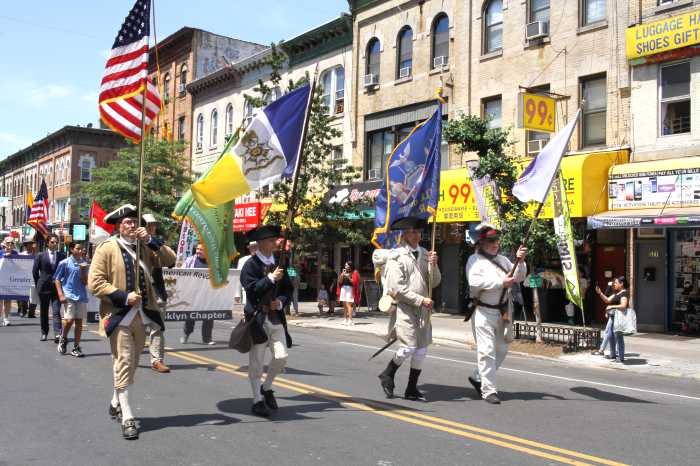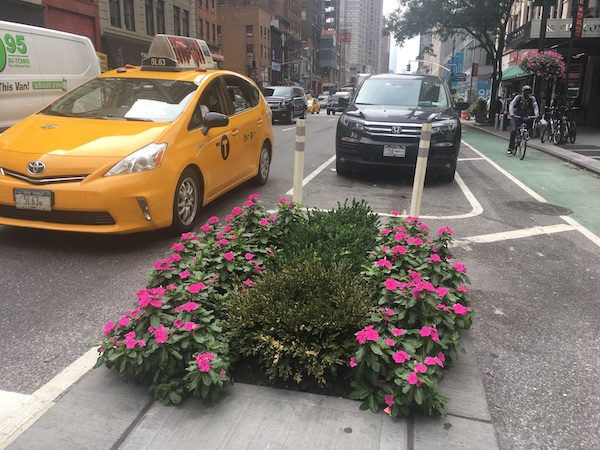
BY REBECCA FIORE | Bustling avenues filled with engine exhaust fumes, misplaced trash bins, reckless street-crossing pedestrians, and the upcoming cold weather are the main concerns of seasoned and fresh gardeners trying their hand at keeping their micro-gardens in Chelsea alive, one year later.
The micro-gardens run parallel to the bike lane on Sixth Ave. that starts at W. Eighth St. The plots were created on elevated concrete pedestrian refuges (aka islands) that separate the bicyclists from motor vehicles. There are 23 micro-gardens spread along 27 islands from W. Ninth St. to W. 32nd St. There is one plot per island and each is four by five feet.
Julie Winters, a micro-garden adopter, said this year she was most impressed with her Russian sage, “which did really well! It must be accustomed to hard conditions. The exhaust from the cars beats the plants. I think next year I will grow something more hardy.”
Winters shares a plot with two others on W. 15th St. She said she has been working with plants for many years now but that “gardening in the middle of the street in New York is a very strange experience. First, I went there and realized I had to wear a fanny pack because you can’t put your purse down on the island. There’s a tiny amount of safe space, between the heavy traffic one side and the bikes on the other side.”
Winters suggested that during the planting season to always bring someone to stand watch, but for watering she goes at it alone.
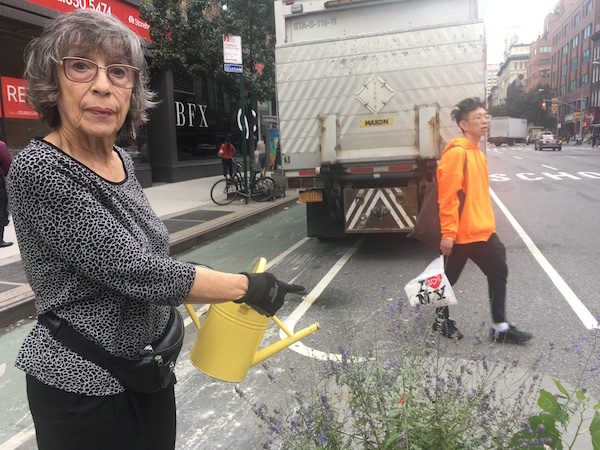
Yoshimi Kono said he agrees about the possible dangers during planting season and is protective of his eight-year-old daughter, Yuma, who helps him on their W. 18th St. plot.
“It’s kind of dangerous in a way, the micro-garden is just next to the street,” he said. “While we are planting, if we step out one foot in the street you are dead. I always tell my daughter to stay on the bicycle side, but the bicyclists in the city are crazy.”
That doesn’t stop Yuma from wanting to help her father out. “She always likes to help. She is so happy, she says, ‘I will do it! I will do it!’ ”
Kono and Yuma have planted the same Japanese flower each season except this past spring. “Asagao” blooms in the morning and by the afternoon shrinks, Kono said. He said he finds gardening to be a natural stress reliever.
“It is nice to have a green area especially in the city because it can be very, very relaxing. The touching of the soil, feeling happy that it is growing. You can feel the seasons.”
During the blooming months, people are cautious around the plants, but during planting season, when nothing is above ground, people tend to step on the garden, which can damage the bulbs underneath. Kono has tried to create a small fence around his garden during that time, but didn’t have much luck fending off careless walking New Yorkers.
Kono said he wishes they had funds for a proper garden fence, like the ones on the sidewalk gardens, which are made out of metal rods. Some gardeners use a cover crop for the colder months as decoration, but Kono said his bulbs are too close to the surface so for now he’s keeping it bare.
Winters and her husband also tried the fence method to ward off unwanted foot traffic, but that didn’t prevent unwanted debris.
“People use it as a garbage dump!” Winters said. “With gloves you have to pull out cigarette butts, cups, and whatever is accumulated there. My husband made a fence to alert people not to walk over it. It stopped people from walking on, but has it stopped people from throwing garbage in it? Oh no.”
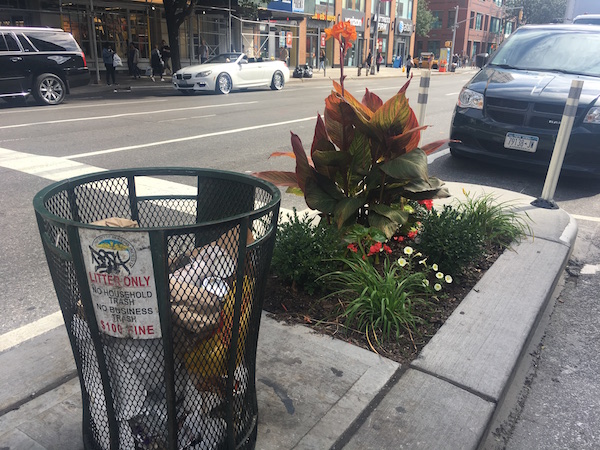
Kono also said that he recently got into an argument with the city’s Department of Sanitation after trash bins that were supposed to be on the sidewalk were left on the median next to the gardens. He said people miss the bins and the trash inevitably ends up in his garden.
Erica Sorg and her plot partner Pete Wilkins both said they don’t have an issue with picking up occasional trash from their plots.
“People seem to appreciate it and aren’t being disrespectful,” Sorg said of her shared micro-garden.
“It’s amazing the amount of thanks you get from passerby,” Wilkins said. “A lot of the time they think we are employees of the city.”
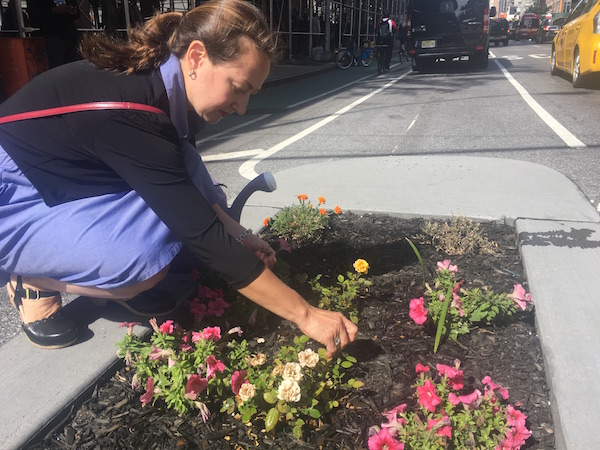
Their two plots, on W. 24th St., have been filled with marigolds, petunias, and miniature roses. The flowers were donated from Trader Joe’s (675 Sixth Ave., btw. W. 21st & 22nd Sts.).
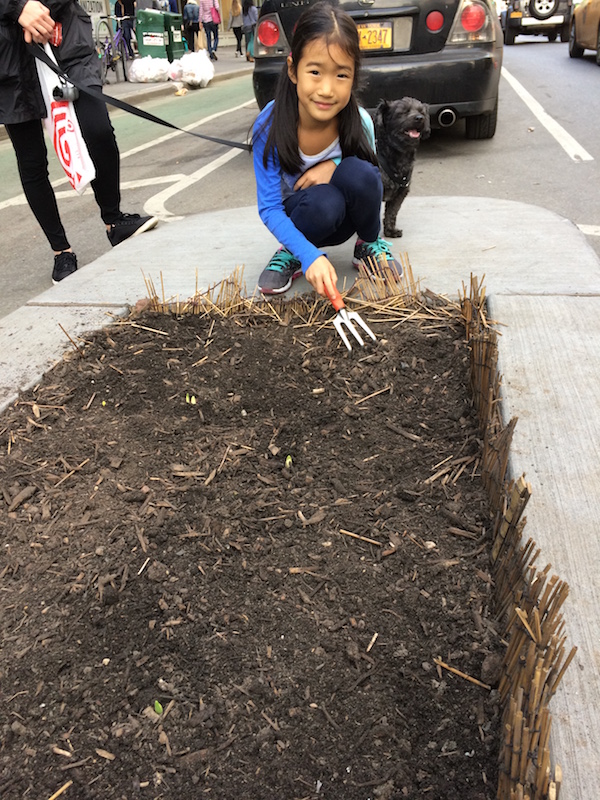
Thanks to outreach from the Chelsea Garden Club, Lowe’s (635 Sixth Ave. btw. W. 19th & 20th Sts.) offers a discount on gardening supplies and plants. Along the avenue, A. Bulfamante Landscaping (which waters trees and micro-gardens maintained by the Flatiron/23rd Street Partnership) has volunteered to water other micro-garden sites pro bono.
Wilkins said he was most impressed by his petunias this year, but in the upcoming months he’s planning on taking out Sorg’s marigolds, which were eaten by insects, and replacing them with mums.
“Mums are pretty hardy and colorful and beautiful. They last well into frost season,” Wilkins said. “Once winter sets in we do have the mulch that’s there that will protect in the winter. Some people also like to use pine branches.”
Each gardener had a different approach for the fall and winter seasons. Winters will put a cover crop on top of her plot, like kale or cabbage to keep the soil rich; Wilkins and Sorg will have mums to brighten the street; and Kono is keeping a bare top to give room for his bulbs underneath to grow.
Sorg, a self-proclaimed green thumb novice, said she is constantly learning from Wilkins and from the flowers themselves. She said she enjoys coming down three times a week to water her plants because it has given her a sense of community.
Even Kono’s daughter Yuma has made new friends in the neighborhood, he said, through working on the micro-gardens.
“Normally, people don’t talk to strangers,” he noted, “but this is a nice compliment, a good experience. Sometimes the neighbors come by and say ‘Hi.’ Sometimes they try to help us. Other neighbors gave us flower bulbs to plant. It’s nice community work, to do together.”
